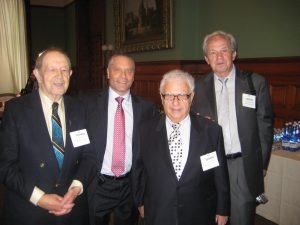While in his early twenties, Steve Gamester went on a backpacking trip across Europe. Absorbed by history, Gamester made sure to visit Auschwitz on his journey through Poland.
Walking around the concentration camp, with a Canadian flag on his backpack, Gamester was surprised to hear the tour guide refer to a section of the camp as “Canada.”
The tour guide explained that Canada was the nickname of a storage area in Auschwitz where workers (known as Canada Commandos) sorted and processed stolen items from victims of the camp. Many of these valuables were sent back to Germany to be kept in the Reichsbank or transported to other Nazi-occupied regions of Europe.
Reflecting back on his trip two decades later, “To have my country mentioned as part of Auschwitz and to have such a tragic connection [to the Holocaust] was very surprising,” Gamester says.
“It’s one [story] that 99 per cent of Canadians don’t know… this strange connection between our country and the most horrible place on Earth.”

The story of the “Canada Commandos” is a key part of the Nov. 7 episode of Hunting Nazi Treasure, an eight-park investigative series that Gamester produces for the History network.
According to the episode, It is estimated that in Poland alone the Nazis stripped two-and-a-half tons of pure gold from concentration camp victims.
The episode earns much of its poignancy from the words of Canada Commando Irene Weiss, who was just 13 when she arrived with her family at Auschwitz.
Weiss is one of only three Commandos still alive today.
A narrator of the episode explains the reasoning behind naming the area Canada, “because in the eyes of the inmates, Canada represented a land of plenty.”
READ: HOLOCAUST EDUCATOR TO RECEIVE MERIT SASKATCHEWAN ORDER OF MERIT
Hunting Nazi Treasure takes a different perspective about the Third Reich on the History channel. It concentrates on the continued efforts to track down the cultural artifacts stolen by the Nazis missing for over 70 years.
The Nov. 7 episode focuses on the gold the Nazis plundered during the Holocaust, which comes out to over $20 billion. Even though Allied soldiers found much of that treasure near the war’s end, not all of it was recovered.
“This was the biggest theft in history,” Gamester tells the CJN, “and in many ways, it’s [now] the largest treasure hunt in history.”
The story of the Canada Commandos relates to this subject in a disturbing way.
As Weiss explains in the episode, death camps provided a grisly opportunity for Nazis to claim Jewish valuables. Gold teeth were removed from many Jews after they died in the gas chambers. After being, smelted down, these nuggets could then be sold in exchange for weapons and other goods.
Meanwhile, Nazi authorities kept records of the names (and numbers) of those Jews who were killed and listed which of their gold teeth had been extracted.
The television series has been in the works since August 2015, when a story about Polish men revealing the location of a train filled with Nazi gold, circulated worldwide.
No evidence of that train or its hidden treasure was unearthed. Nonetheless, Gamester says the heads of the History network were fascinated by the culture of hunting for war goods that still exists around Europe.
Some of those searchers include local hobbyists who wander the Bavarian forests with metal detectors, as well as more established foundations working to track down and recover valuable works of art and decoration.
“These cultural treasures that are still missing are in some way the last prisoners of the Nazis,” Gamester says.
Gamester believes the world will be looking for this items for many years.







